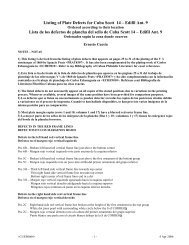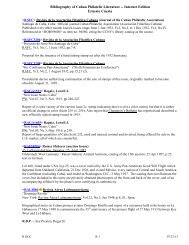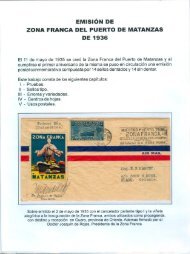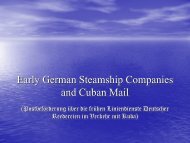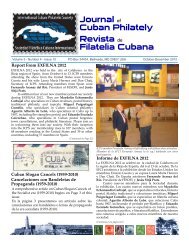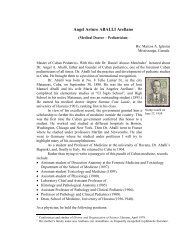The Cuban Philatelist - Ernesto Cuesta
The Cuban Philatelist - Ernesto Cuesta
The Cuban Philatelist - Ernesto Cuesta
Create successful ePaper yourself
Turn your PDF publications into a flip-book with our unique Google optimized e-Paper software.
fue domesticada para producir raíces con un alto contenido de<br />
carbohidratos. Previo a la conquista española, la yuca era la<br />
principal fuente de carbohidratos para un tercio de la población<br />
indígena de América. La harina cocida de la yuca se llama<br />
casava y su masa lavada con agua es la tapioca, nombres que<br />
han sobrevivido hasta hoy en el léxico cubano.<br />
Román Compañy diseñó los sellos que fueron<br />
producidos en la imprenta William Soler de La Habana mediante<br />
el proceso “offset” multicolor en hojas de cuarenta. También se<br />
prepararon pequeñas cantidades de hojitas de recuerdo oficiales<br />
con los diseños de de los sellos de ESPAMER ’85. En la<br />
exposición se mostraron una selección de artefactos taínos del<br />
Museo Antropológico Montané para enfatizar el tema indígena.<br />
El catálogo oficial de la exhibición incluye un artículo del<br />
destacado arqueólogo cubano Ramón Dacal Mouré describiendo<br />
brevemente las diversas piezas taínas en la exhibición.<br />
Las ilustraciones de 1985 muestran una imagen más<br />
realista de los taínos, llevando a cabo actividades que se han<br />
confirmado por estudios arqueológicos y antropológicos. El<br />
gobierno cubano se enorgullese de su herencia de taínos y<br />
siboneyes en la isla, financiando importantes excavaciones y<br />
preservando las localidades existentes. En Cuba, la<br />
investigación del antropólogo cubano Manuel Rivero de la Calle<br />
en los 1960 y 1970 confirmó la existencia de descendientes<br />
mestizos de los Taínos en el Valle de Yateras al norte de la Bahía<br />
de Guantánamo. Previamente se creía que los taínos estaban<br />
extintos. Desde 1996 se celebra una conferencia anual en<br />
Baracoa patrocinada en parte por la Universidad de Cornell<br />
dedicada a estudios de los taínos y amerindios.<br />
Entre 1986 y 1992, en anticipación de la<br />
conmemoración del 500 aniversario del descubrimiento de<br />
América por el Almirante Colón, Cuba emitió una serie anual<br />
conmemorativa de veinte sellos denominada Historia de<br />
Latinoamérica. El maestro diseñador del MINCOM Carlos<br />
Echenagusía hizo los diseños de las series de 1986 y 1992; José<br />
A. Medina diseñó los sellos de 1987. Los mismos fueron<br />
impresos en la imprenta William Soler de La Habana en dos<br />
formatos – una hoja de cuarenta sellos de la serie ordinaria con<br />
una columna de cinco sellos y ocho filas de una denominación, y<br />
una hoja con un formato especial de veinte sellos diferentes. La<br />
serie de 1986 está dedicada a las culturas amerindiaa, mostrando<br />
artefactos y estructuras de 16 naciones latinoamericanas. El<br />
sello de 5 centavos representando a Cuba (Scott 2893) muestra al<br />
Idolo del Tabaco del Museo Antropológico Montané a su<br />
izquierda y la casa redonda típica de los taínos llamada caney a<br />
su derecha.<br />
El sello que representa a la República Dominicana<br />
(Scott 2895) muestra una villa costera en zancos y un dujo<br />
ceremonial. Actualmente se están excavando los restos de una<br />
villa costera similar en los Los Buchillones en la provincia de<br />
Matanzas. La reconstruída villa taína de Guamá es también una<br />
réplica de una villa costera. El cronista español Bartolomé de las<br />
Casas describe el pueblo taíno de Carahate en la costa norte de<br />
Cuba con casas “sobre horcones en el agua,” refiriéndose a la<br />
villa costera construída en plataformas sobre el mar. La imagen<br />
del dujo parece haber sido copiada del dujo de Santa Fe en el<br />
for a third of the indigenous population of the Americas. <strong>The</strong><br />
cooked yucca flour was called casava and the water-filtered<br />
yucca starch tapioca, names that survive to this day in the<br />
<strong>Cuban</strong> Spanish lexicon.<br />
Roman Compañy designed the stamps, which were<br />
printed at the William Soler printworks in Havana using<br />
multicolor offset in sheets of forty stamps. An official keepsake<br />
souvenir sheet, showing the designs of the ESPAMER ’85<br />
stamps and souvenir sheet was also prepared in small<br />
quantities. A selection of Taino artifacts from the Montane<br />
Anthropological Museum was displayed at the exhibition,<br />
highlighting a Taino theme. <strong>The</strong> official exhibition catalog<br />
includes an article by noted <strong>Cuban</strong> archeologist Ramon Dacal<br />
Moure giving brief profiles of the various Taino artifacts<br />
exhibited at the show.<br />
<strong>The</strong> 1985 illustrations show a more realistic image of<br />
the Taino, engaged in activities that have been confirmed with<br />
archaeological and anthropological study. <strong>The</strong> <strong>Cuban</strong><br />
government takes great pride in the Taino and Siboney<br />
ancestry of the island, funding major excavations and<br />
conserving existent locations. In Cuba, research by <strong>Cuban</strong><br />
anthropologist Manuel Rivero de la Calle in the 1960s and<br />
1970s confirmed the existence of mixed blood Taino<br />
descendants in the Yateras Valley above Guantanamo Bay.<br />
Previously, the Taino were believed to be extinct. Since 1996,<br />
a yearly conference co-sponsored by Cornell University is held<br />
at Baracoa, showcasing Taino and Amerindian studies.<br />
From 1986 to 1992, in anticipation of the<br />
commemoration of the 500th anniversary of the discovery of<br />
the Americas by Admiral Columbus, Cuba issued a yearly<br />
commemorative twenty stamp series denominated History of<br />
Latinamerica. Master MINCOM designer Carlos Echenagusia<br />
did the designs for the 1986 and 1992 series; Jose A. Medina<br />
designed the 1987 stamps. <strong>The</strong> stamps were printed at the<br />
William Soler printworks in Havana in two formats – a regular<br />
issue sheet of forty stamps with a column of five stamps of one<br />
denomination with eight rows across, and a special format<br />
sheet of twenty stamps with all different twenty designs in the<br />
series. <strong>The</strong> 1986 series is dedicated to Amerindian cultures,<br />
showing artifacts and structures from sixteen different<br />
Latinamerican nations. <strong>The</strong> 5 centavos stamp representing<br />
Cuba (Scott 2893) shows the Idolo del Tabaco figurine in the<br />
Montane Anthropological Museum to the left and round walled<br />
houses called caney to the right that housed the majority of the<br />
Taino.<br />
<strong>The</strong> stamp representing the Dominican Republic<br />
(Scott 2895) shows a coastal village on stilts and a ceremonial<br />
dujo. <strong>The</strong> remains of a similar coastal village are currently<br />
under excavation in Cuba at Los Buchillones in Matanzas<br />
province. <strong>The</strong> reconstructed Taino village of Guama also<br />
replicates such a coastal village. <strong>The</strong> Spanish chronicler<br />
Bartolome de las Casas describes the Taino town of Carahate<br />
on the north coast of Cuba as having houses “sobre horcones<br />
en el agua,” describing a coastal village built on platforms over<br />
the sea. <strong>The</strong> image of the dujo artifact appears to be drawn<br />
from the Santa Fe dujo at the Montané Anthropological<br />
83 <strong>The</strong> <strong>Cuban</strong> <strong>Philatelist</strong>. Last Half 2005.



